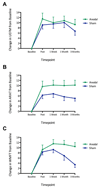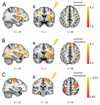Ipsilesional anodal tDCS enhances the functional benefits of rehabilitation in patients after stroke
- PMID: 27089207
- PMCID: PMC5388180
- DOI: 10.1126/scitranslmed.aad5651
Ipsilesional anodal tDCS enhances the functional benefits of rehabilitation in patients after stroke
Abstract
Anodal transcranial direct current stimulation (tDCS) can boost the effects of motor training and facilitate plasticity in the healthy human brain. Motor rehabilitation depends on learning and plasticity, and motor learning can occur after stroke. We tested whether brain stimulation using anodal tDCS added to motor training could improve rehabilitation outcomes in patients after stroke. We performed a randomized, controlled trial in 24 patients at least 6 months after a first unilateral stroke not directly involving the primary motor cortex. Patients received either anodal tDCS (n= 11) or sham treatment (n= 13) paired with daily motor training for 9 days. We observed improvements that persisted for at least 3 months post-intervention after anodal tDCS compared to sham treatment on the Action Research Arm Test (ARAT) and Wolf Motor Function Test (WMFT) but not on the Upper Extremity Fugl-Meyer (UEFM) score. Functional magnetic resonance imaging (MRI) showed increased activity during movement of the affected hand in the ipsilesional motor and premotor cortex in the anodal tDCS group compared to the sham treatment group. Structural MRI revealed intervention-related increases in gray matter volume in cortical areas, including ipsilesional motor and premotor cortex after anodal tDCS but not sham treatment. The addition of ipsilesional anodal tDCS to a 9-day motor training program improved long-term clinical outcomes relative to sham treatment in patients after stroke.
Copyright © 2016, American Association for the Advancement of Science.
Conflict of interest statement
Figures


References
-
- Kwakkel G, Wagenaar RC, Twisk JW, Lankhorst GJ, Koetsier JC. Intensity of leg and arm training after primary middle-cerebral-artery stroke: a randomised trial. Lancet. 1999;354:191. - PubMed
-
- Stagg C, Johansen-Berg H. In: Stroke Rehabilitation: Insights from Neuroscience and Imaging. Carey LM, editor. Oxford University Press; Oxford: 2011.
-
- Krakauer JW. Motor learning: its relevance to stroke recovery and neurorehabilitation. Curr Opin Neurol. 2006;19:84–90. - PubMed
-
- Matthews PM, Johansen-Berg H, Reddy H. Non-invasive mapping of brain functions and brain recovery: Applying lessions from cognitive neuroscience to neurorehabilitation. Restor Neurol Neurosci. 2004;20:1–16. - PubMed
Publication types
MeSH terms
Grants and funding
LinkOut - more resources
Full Text Sources
Other Literature Sources
Medical

